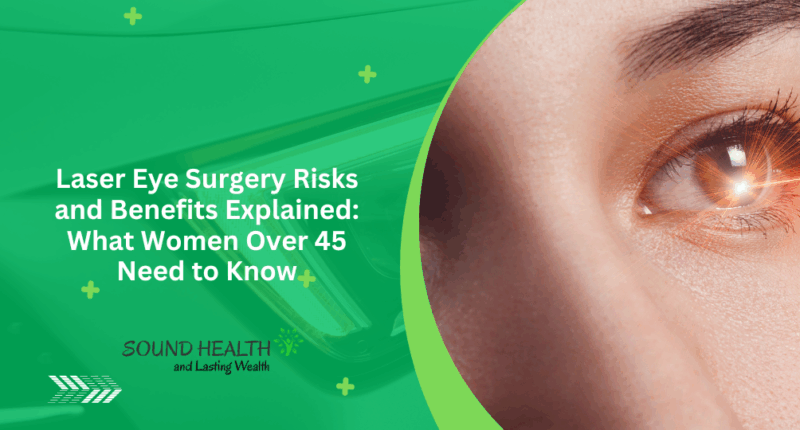Laser eye surgery stands as a popular choice for vision correction, promising freedom from glasses or contact lenses. With millions undergoing procedures worldwide, understanding its risks and benefits is crucial, especially for women over 45 considering their unique visual needs. This article offers a thorough explanation to help you make an informed decision, featuring insights from ophthalmologist Christopher T. Hood, MD, Medical Director of the Cornea, Cataract and Refractive Surgery Clinic at the University of Michigan.

What Is Laser Eye Surgery? A Clear Look at Vision Correction
Laser eye surgery is a medical procedure that reshapes the cornea to improve vision and reduce dependence on corrective lenses. The most common technique, LASIK (Laser-Assisted In Situ Keratomileusis), uses a laser to create a flap in the cornea, then reshapes the underlying tissue. Another method, PRK (Photorefractive Keratectomy), although less common, involves removing the surface layer of the cornea before reshaping, allowing it to heal naturally. This option is often chosen when corneal thickness is insufficient for LASIK.
Patients typically seek these surgeries for nearsightedness, farsightedness, or astigmatism, achieving 20/25 vision or better in about 90% of cases. The quick recovery time and long-term benefits attract millions. However, it’s important to realize that this procedure is not without its potential complications.
PRK Laser Eye Surgery: A Less Common But Valuable Option
While LASIK remains the prevalent choice, PRK stands out as a viable alternative for those with thinner corneas or certain corneal irregularities. Recovery from PRK tends to be longer and involves more discomfort initially, but it eliminates the flap complication risk inherent to LASIK. According to clinical data, PRK patients experience similar visual outcomes, with a slightly extended healing period of up to six weeks.
3 Rare Laser Eye Surgery Risks You Should Know About
Every surgical procedure carries risks, and laser eye surgery is no exception. Although uncommon, the following rare risks deserve attention:
- Corneal ectasia: A weakening and bulging of the cornea post-surgery, potentially leading to vision distortion. This risk is mitigated by thorough preoperative screening.
- Infection: Though infrequent, it can severely impact vision if not promptly treated.
- Visual disturbances: Including glare, halos, and double vision, especially in low light or nighttime conditions, which may persist for months or longer.
The rarity of these complications does not diminish their seriousness, making risk evaluation a critical step.
Risk Factors to Consider Before Laser Eye Surgery
Choosing laser eye surgery involves assessing personal factors that affect outcomes. Age, corneal thickness, pupil size, and overall eye health play pivotal roles. Women over 45, for instance, often begin experiencing presbyopia—difficulty focusing on close objects—due to the natural aging of the eye’s lens. This factor can influence postoperative satisfaction.
Health conditions such as autoimmune disease, diabetes, or dry eye syndrome can also increase surgical risks or affect healing. A comprehensive exam and candid discussion with your surgeon help weigh these aspects carefully.
Alternatives to Laser Eye Surgery for Vision Correction
For those who may not be ideal candidates or prefer non-surgical options, alternatives include:
- Orthokeratology: Special contact lenses worn overnight that temporarily reshape the cornea.
- Phakic intraocular lenses: Implanted lenses used for vision correction without removing corneal tissue.
- Traditional eyeglasses or contact lenses: Reliable options that remain safe and effective.
Each alternative carries its own range of benefits and limitations, suited to individual lifestyles and eye conditions.
Over 45? Ask About Monovision: A Smart Solution for Age-Related Vision Changes
Women over 45 face the challenge of presbyopia, which laser eye surgery does not typically address alone. Monovision is a technique where one eye is corrected for distance vision and the other for near tasks. This approach can lessen dependence on reading glasses while preserving overall sight.
Dr. Christopher T. Hood explains, “Monovision is an effective adaptation for patients entering the presbyopic phase, offering a practical balance between sharp distance and near vision without additional procedures.”
The Bottom Line on Laser Eye Surgery Risk
Laser eye surgery offers tremendous benefits like freedom from corrective lenses and high success rates; however, understanding the risks and limitations is vital. Most patients achieve excellent vision with minimal side effects. Yet, individualized assessment ensures that potential complications are minimized, and expectations are aligned with realistic outcomes.
Ophthalmologists like Dr. Hood emphasize, “Choosing a qualified surgeon, undergoing meticulous preoperative screening, and having a full grasp of the procedure’s advantages and risks are essential for a satisfactory experience.”
Also Read | How Women Over 50 Can Reverse Insulin Resistance Quickly









